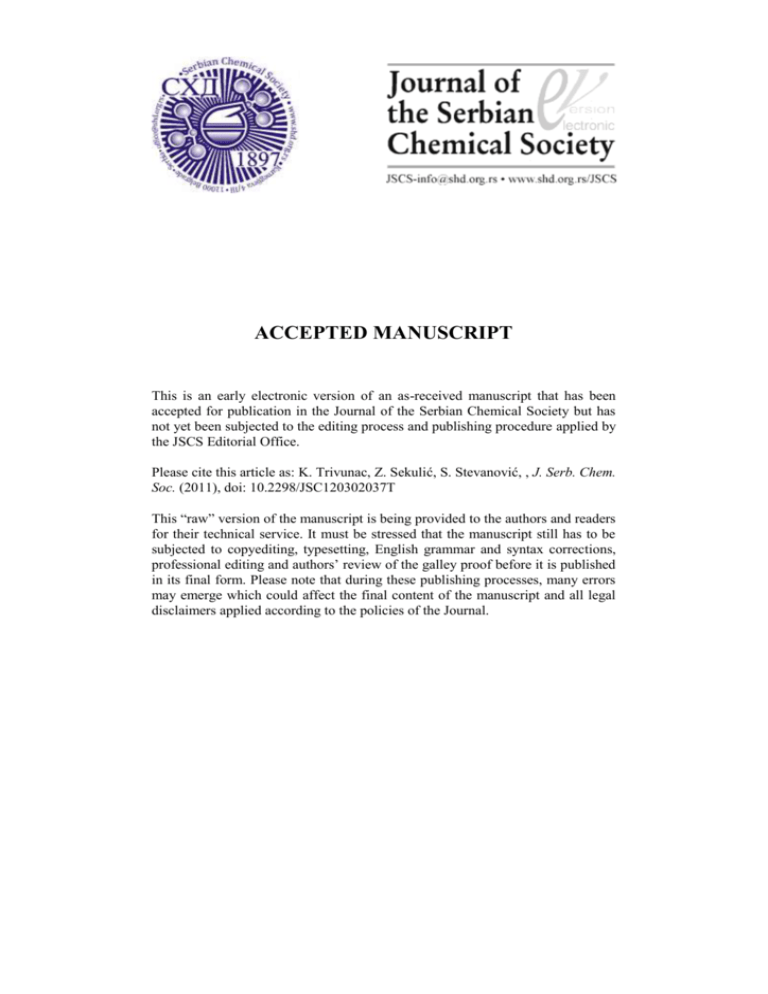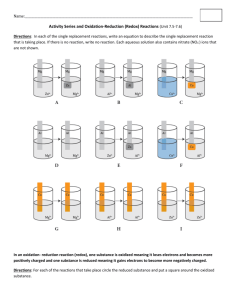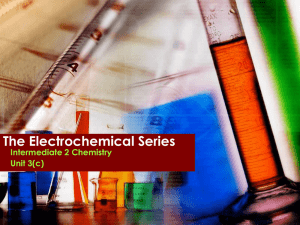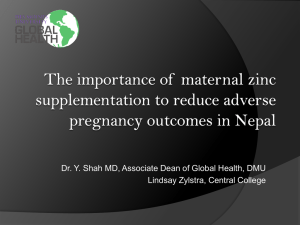Effect of an industrial chemical waste on the uptake
advertisement

ACCEPTED MANUSCRIPT This is an early electronic version of an as-received manuscript that has been accepted for publication in the Journal of the Serbian Chemical Society but has not yet been subjected to the editing process and publishing procedure applied by the JSCS Editorial Office. Please cite this article as: K. Trivunac, Z. Sekulić, S. Stevanović, , J. Serb. Chem. Soc. (2011), doi: 10.2298/JSC120302037T This “raw” version of the manuscript is being provided to the authors and readers for their technical service. It must be stressed that the manuscript still has to be subjected to copyediting, typesetting, English grammar and syntax corrections, professional editing and authors’ review of the galley proof before it is published in its final form. Please note that during these publishing processes, many errors may emerge which could affect the final content of the manuscript and all legal disclaimers applied according to the policies of the Journal. J. Serb. Chem. Soc. 77 (0) 1–14 (2012) JSCS–5324 UDC Original scientific paper 1 2 Zinc removal from wastewater by a complexation–microfiltration process 3 KATARINA TRIVUNAC1*, ZORAN SEKULIĆ2 and SLAVICA STEVANOVIĆ1 4 5 6 1University of Belgrade, Faculty of Technology and Metallurgy, Department of Analytical Chemistry and Quality Control, Karnegijeva 4, 11120 Belgrade, Serbia and 2Institute of Public Health of Belgrade, Bul. Despota Stefana 54a, 11000 Belgrade, Serbia 7 (Received 2 March, revised 19 April 2012) 8 9 10 11 12 13 14 15 16 17 18 19 20 21 22 23 24 25 26 27 28 Abstract: Due to its wide industrial applications, zinc has become an important contaminant in aquatic environments since it is a toxic heavy metal and some of its compounds, such as zinc arsenate and zinc cyanide, may be extremely hazardous. Therefore, there is a growing need to develop simple methods capable of separating and recovering trace zinc from environmental waters. Nowadays, ultra- and micro-filtration methods for trace metals removal from waters by the addition of a water-soluble polymer into the aqueous solutions have become a significant area of research. The choice of water-soluble macroligands remains important for the development of this technology. Sodium carboxymethyl cellulose (Na-CMC) was selected as the complexing agent. The microfiltration experiments were performed in a stirred dead-end cell. Versapor membranes were used to separate the formed polymer–metal complex. The concentration of heavy metal ions after microfiltration in aqueous solution was determined using atomic absorption spectroscopy (AAS). The effects of the amount of complexing agent, pH value, type of anion, ionic strength and operating pressure on the flux (J) and rejection coefficient (R) were investigated. Experimental results indicate a considerable influence of the pH, ionic strength and type of anion on the rejection coefficient, while the effect of the amount of the complexing agent was relatively insignificant. The Na-CMC used in the research proved very effective, which is supported by the high rejection coefficients obtained (99 %). 29 30 Keywords: microfiltration; complexation; heavy metal ions; wastewater treatment. 31 32 33 34 INTRODUCTION Zinc is an essential heavy metal for biological functions; however in high concentrations, it can be harmful to people and animals. The toxicity of heavy metal contamination, however, is highly dependent on the chemical form of the * Corresponding author. E-mail: trivunac@tmf.bg.ac.rs doi: 10.2298/JSC120302037T 1 2 35 36 37 38 39 40 41 42 43 44 45 46 47 48 49 50 51 52 53 54 55 56 57 58 59 60 61 62 63 64 65 66 67 68 69 70 71 72 73 74 TRIVUNAC, SEKULIĆ and STEVANOVIĆ metal in question. Dissolved free ions are more toxic than metals that are bound in particles or to organic compounds. Zinc is naturally present in water. Industrial wastewaters containing zinc stem from galvanic industries, battery production, etc. Zinc compounds are applied for many different purposes. Zinc chloride is applied for parchment production, zinc oxide is a constituent of salves, paints and catalysts, and zinc vitriol is applied as a fertilizer. Zinc leaks from zinc pipes and rain pipes, consequential to the circulation of carbon-rich water. Car tires containing zinc and motor oil from zinc tanks release zinc compounds on roads. Zinc compounds are present in fungicides and insecticides, and consequently end up in water. When inadequate safety measures are taken, zinc may be emitted from chemical waste dumps and landfills, or from dredge mortar. Zinc may be removed from water by different methods. To achieve a level that meets legal standards, techniques such as coagulation, ion exchange, sand filtration and active carbon may be applied.1 The continuous increase of world needs for most of the known metals, the decrease in the grade of the available ores and strict environmental regulations make it of interest to find effective and efficient methods for processing waste solutions containing metal ions, even at very low concentrations. The efficient and selective separation of heavy metal ions can be achieved by using watersoluble macroligands in combination with membrane filtration.2 The use of membrane separation processes in the treatment of wastewater containing toxic metal ions is today an attractive and suitable technique, and is easily included in the whole process. For this reason, membrane separations are being employed more and more frequently. Moreover, the separation can be performed at room temperature; the modular membrane surface can be easily adjusted to the wastewater flow and various industrial membranes are now available. In order to retain metallic ions, reverse osmosis (or at least nano-filtration) can be used due to the size of the ions in aqueous solutions. However, the usual permeate fluxes of reverse osmosis membranes are limited and require high transmembrane pressure, which makes the process expensive.3 There are two widely used separation techniques among the membrane methods for the removal of heavy metal ions from aqueous solutions: micellar enhanced ultrafiltration (MEUF) and polyelectrolyte ultrafiltration (PEUF). MEUF4–7 and PEUF8–26 combine ultrafiltration with the presence of water-soluble surfactants and polymers, respectively. The enhanced ultrafiltration processes have the advantages of operation at relatively low pressures and temperatures, resulting in excellent rejection of multivalent metals and organics. PEUF is the combination of two phenomena, the binding of metal ions to a water-soluble natural or synthetic polyelectrolyte, and ultrafiltration. Since the pore size of ultrafiltration membranes are not suitable to separate heavy metal ions, water-soluble polymers ZINC REMOVAL FROM WASTEWATER 3 75 76 are used to bind the metals to form macromolecular complexes rejected by ultrafiltration. 77 78 79 80 81 82 83 84 85 86 87 88 89 90 91 92 93 94 95 96 97 98 99 100 101 102 103 104 105 106 107 108 109 110 THEORY AND EXPERIMENTAL The removal and rejection of heavy metal ions from aqueous solutions has been traditionally carried out by chemical precipitation, ion exchange, adsorption, etc. Nowadays, ultra- and micro-filtration methods for trace metals removal from waters by the addition of a water-soluble polymer into the aqueous solutions have become a significant research area. This method is based on the principles that polymers with a large molecular weight could bind heavy metal ions to form macromolecular complexes. Their metal complexes could then be retained and concentrated by a microfiltration membrane, whereas unbound metal ions would pass through the membrane. Up to now, many polymers, such as poly(vinyl alcohol) and sulfonated poly(vinyl alcohol),8,9 poly(ammonium acrylate),10 poly(acrylic acid),11–13 polyethyleneimine,13–17 diethylaminoethyl cellulose,18 poly(4-vinylpyridine) and poly(diallyl dimethylammonium) chloride,21 poly(vinyl sulfonic acid),22 partially ethoxylated polyethylenimine23,24 and chitosan and pectin15,25 have been used for metal removal from wastewaters. Sodium carboxymethyl cellulose (Na-CMC) is a derivative of cellulose that is colorless, odorless and tasteless, physiologically inert, chemically stable, not dangerous for health or the environment and is water-soluble. It also possesses good complexation ability for some metal ions and was chosen as the macromolecular complexing agent for the selective removal and rejection of copper from water in a complexation–microfiltration process.20 The aim of the present research was to evaluate the efficiency of Na-CMS in the removal of zinc ions from water. The experiments were conducted on two model solutions, ZnCl2 (solution 1) and Zn(CH3COO)2 (solution 2) in order that the influence of the anion be investigated. The initial concentration of zinc ions in both solutions was 50.00 mg dm-3. The microfiltration experiments were performed in a stirred dead-end cell Millipore 8050. The influence of different experimental parameters, i.e., the amount of complexing agent, ionic strength, pH value and operating pressure, on the flux and rejection coefficient were investigated. Versapor polyacrylic membrane 200 filters (Gelman Sciences Inc., USA) were used to separate the formed polymer–metal complex. A feed volume of 25.0 cm3 of concentration 50.0 mg Zn dm-3 and the desired Na-CMC concentration were prepared and stirred for 1 hour at room temperature before t filtration. Experiments with longer mixing time demonstrated that 1 hour was sufficient to reach the complexation equilibrium. The pH was adjusted with HCl and NaOH solutions. The concentration of heavy metal ions in aqueous solution after microfiltration was determined using atomic absorption spectroscopy (Pye Unicam SP9, Philips) at 213.9 nm. 111 RESULTS AND DISCUSSION 112 113 114 The effects of the amount of complexing agent, ionic strength, pH value and operating pressure on the flux and rejection coefficient were investigated. The flux, J, of solution containing Zn(II)-ions was calculated from equation: V (1) J A 115 4 TRIVUNAC, SEKULIĆ and STEVANOVIĆ 116 117 118 where V is the volume of the permeate, A is the effective membrane area and is time. The rejection, R, of Zn-ions was calculated from equation: 119 cp R 1 100 cf 120 121 where cp and cf are the concentrations of zinc ions in the permeate and feed, respectively. 122 Effect of pressure 123 124 125 126 127 128 129 130 131 The effect of applied pressure was investigated at a fixed initial concentration of zinc ions of 50.0 mol dm–3, pH 9.0 and pressure of nitrogen in the range 100–400 kPa. The flux of the solute was lower than that of pure water. From the shape of the curve in Fig. 1, it could be concluded that no sharp change in the curve of flux vs. pressure was found, although the flux was still a slight function of pressure at higher pressure. This indicates that a concentration polarization exists but no plateau was reached; hence, the gel-polarization effect was not dominant for the polymer in the pressure range studied. 132 Effect of sample pH on the rejection of zinc 133 134 135 136 137 138 139 140 141 142 143 144 145 The effects of the solution pH in the range 2.0–9.0, at a fixed concentration of zinc ions of 50.0 mg dm–3 and pressure of 100 kPa were evaluated. A strong influence of the pH of the solution on the retention was observed in complexation-microfiltration process. Increasing the pH leads to an increase in the concentration of deprotoned carboxylic groups, which favors the formation of macromolecular polymer–metal complexes and subsequently increases in the metal rejection coefficients. As can be seen in Fig. 2, the rejection of zinc was increased with increasing pH value until the rejection reached its maximum (99 %) at pH 8.0 and then a flat profile was maintained when the pH was changed to 10.0. With increasing pH, more and more carboxymethyl groups dissociate gradually and complex with zinc ions. At low pH values, a large number of the H3O+ groups occupy the positions, which prevent the target zinc ions from form complexes with Na-CMC. 146 Effect of polymer concentration on zinc ion retention 147 148 149 150 151 152 The effect of the Na-CMC concentration on zinc removal was studied pH 6.8 and pH 8.3 using solution 1 and solution 2 containing 50.0 mol dm–3 of Zn and the concentration of Na-CMC was varied in range of 40–320 mg dm–3. The retention values of Zn(II) at different Na-CMC concentrations at pH 6.3 for both solutions are plotted in Fig. 3, from which it could be seen that the retention of Zn(II) remained almost constant at a value of around 89 % for all (2) ZINC REMOVAL FROM WASTEWATER 5 153 154 155 156 157 158 159 160 161 162 163 164 165 employed Na-CMC concentrations. It was also shown that the rejection of Zn(II), was not significantly affected by the Na-CMC concentration. Moreover, it was found that Na-CMC even at a very low concentration has the capability to bind with the metal to form macromolecular complexes as an effective complexing agent. The explanation of this behavior is that equilibrium existed between free zinc ions, Na-CMC molecules and the formed complexes, and indicates that NaCMC could be employed as a very effective water-soluble polymer for the removal of zinc(II). A similar behavior was observed at pH 8.3 (Fig. 4.). The retention remained almost constant at a value of around 85 % for solution 1 and 97 % for solution 2. Besides the influence of pH, the presence of the carboxyl anion in solution 2 affects the stability of the formed complexes and thus increases the retention of this solution. 166 Effects of ionic strength on the retention 167 168 169 170 171 172 173 174 175 176 177 178 179 180 181 182 183 184 185 186 187 188 189 190 191 192 The ionic strength of an aqueous stream may greatly affect the effectiveness of polymer-assisted microfiltration processes. Increasing the salt concentration leads to compression of the electrical double layer and thus to a reduction in the electrostatic attraction between ions and charged polymers. As a result, the unbound metals in the solution pass through the membrane leading to lower retention.25 The effect of ionic strength on Zn(II) retention was examined at pH 6.8 and pH 8.3 by adding increasing amount of NaNO3 into the solution. The effect of ionic strength on Zn(II) retention was observed to be more pronounced at pH 6.8 than at pH 8.3, especially at high salt concentrations. As shown in Fig. 5, at pH 6.8, the rejection decreased sharply in the presence of 0.05 mol dm–3 with a reduction of 40 % and 50% for solution 1 and 2, respectively. On increasing the salt concentration (up to 0.5 mol dm–3 NaNO3), no further decline of the retention was observed. These results can be explained by a conformational change of the polymer chains, a competitive adsorption between Na and Zn ions on the negatively charged polymer and an attenuation of the electrostatic repulsion. It is well known that negatively charged polyelectrolytes interact with positively charged divalent metal ions stronger than with monovalent ions.26 Nevertheless, the filtration of metal ions and their subsequent release from the polymer induces an increase of the net negative charge on the polymer surface and then an expansion of the chains in order to increase the total surface, thereby minimizing the electrostatic repulsions. Related with this, the decrease on the surface charge density of the polymer induces a decrease in the strength of the interactions with the metal ions and, consequently, their easier release to the solution from the polymer domain during filtration. 6 TRIVUNAC, SEKULIĆ and STEVANOVIĆ 193 194 195 196 197 198 199 200 201 At pH 8.3, the effect of salt addition was observed over a wider concentration range, i.e., between 0.05 and 1.0 mol dm–3 NaNO3. As shown in Fig. 6, at pH 8.3, the addition of 0.05–0.1 mol dm–3 NaNO3 caused only a 1–3 % decrease in the retention values. Since Zn(II)-Na-CMC complexation is more favorable at pH 8.3 and the bond is probably stronger than the one formed at pH 6.8, it can withstand changes in ionic strength. On increasing the salt concentration to 0.5 mol dm–3 NaNO3, the retention dropped by around 28 % for both solutions. On the increasing the salt concentration further to 1.0 mol dm–3 NaNO3, the slight increase in the rejection by 2–5 % is relatively insignificant. 202 CONCLUSIONS 203 204 205 206 207 208 209 210 211 212 213 214 215 216 217 218 219 220 A complexation–microfiltration process was successfully applied for removal of Zn(II) ions from synthetic wastewater solutions. A polyacrylic membrane was used for filtration process, while carboxymethyl cellulose was used as the metal complexing agent. It was shown that the complexation and filtration processes were pH dependent, the metal rejection was more efficient at neutral and alkaline conditions than at acidic ones. The Na-CMC used in the research proved to be very effective, which is evidenced by the high retention coefficients obtained. It was found that even at very low concentrations, NaCMC has the capability to bind with zinc ions to form macromolecular complexes and is thus an effective complexing agent. The effect of ionic strength on Zn(II) retention was observed to be more pronounced at pH 6.8 than at pH 8.3, especially at high salt concentrations. Influence of anions proved to be very important for complexation process and stability of formed complexes. The process is characterized by low-energy requirements involved in the microfiltration, very fast reaction kinetics and high selectivity for the metal ion separation. For developing a practical process, other important factors and operational parameters, such as different concentration of metal ions, mixture of metal ions, different anions, other membranes, etc., must be studied. 221 222 Acknowledgement. This work was financially supported by the Ministry of Education, Science and Technological Development of the Republic of Serbia (Project No. ON 172007). 223 224 225 226 227 228 229 230 231 232 ИЗВОД УКЛАЊАЊЕ ЦИНКА ИЗ ОТПАДНИХ ВОДА КОМПЛЕКСИРАЈУЋЕМИКРОФИЛТРАЦИОНИМ ПРОЦЕСОМ КАТАРИНА ТРИВУНАЦ1, ЗОРАН СЕКУЛИЋ2 и СЛАВИЦА СТЕВАНОВИЋ1 Универзитет у Београду, Технолошко–металуршки факултет, Катедра за аналитичку хемију и контролу квалитета, п. пр.494, Карнегијева 4, 11120 Београд и 2Градски завод за јавно здравље Београд, Бул. Деспота Стефана 54а, 11000 Београд, Србија 1 Као резултат његове широке индустријске примене, цинк и његова једињења су постали значајне загађујуће материје водених ресурса. Због тога је постало неопходно развијати нове методе за њихово уклањање, које би биле ефикасне, једноставне и ZINC REMOVAL FROM WASTEWATER 233 234 235 236 237 238 239 240 241 242 243 244 245 246 247 248 249 250 251 252 253 254 255 256 257 258 259 260 261 262 263 264 265 266 267 268 269 270 271 272 273 274 275 276 277 7 нешкодљиве по животну средину. Међу њима, метода мембранске филтрације се показала као веома успешна за уклањање различитих загађујућих материја, посебно у комбинацији са макромолекулима. Велики број истраживања усмерен је на избор селективног и специфичног макромолекула. У раду је проучаван комплексирајуће-филтрациони процес за уклањање јона цинка помоћу натријум карбоксиметил целулозе. Микрофилтрација је вршена у ћелији са мешањем. Сепарација формираних комплекса је вршена на Версапор микрофилтрационим мембранама. Концентрација јона метала после микрофилтрације је одређена атомском апсорпционом спектроскопијом. Испитани су утицаји количине комплексирајућег средства, pH вредности раствора, радног притиска, јонске јачине и ањона на флукс и коефицијент задржавања. Експериментални резултати су показали значајан утицај pH, јонске јачине и ањона на коефицијент задржавања, док концентрација комплексирајућег средства није имала значајан утицај на процес. Натријум карбоксиметил целулоза се показала као успешно средство за уклањање јона цинка што се може закључити на основу постигнутог веома високог коефицијента задржавања јона цинка од 99 %. (Примљенo 2. марта, прихваћено 19 априла 2012) REFERENCES 1. F. Fu, Q. Wang, J. Environ. Manage. 92 (2011) 407 2. G. M. Geise, H.-S. Lee, D. J. Miller, B. D. Freeman, J. E. McGrath, J. Polym. Sci. Part B: Polym. Phys. 48 (2010) 1685 3. L. F. Greenlee, D. F. Lawler, B. D. Freeman, B. Marrrot, P. Moulin, Water Res. 43 (2009) 2317 4. E. Samper, M. Rodríguez, M. A. De la Rubiа, D. Prats, Sep. Purif. Technol. 65 (2009) 337 5. J. Landaburu-Aguirre, V. García, E. Pongracz, R. L. Keiski, Desalination 240 (2009) 262 6. R. S. Juang, Y. Y. Xu, C. L. Chen, J. Membr. Sci. 218 (2003) 257 7. E. Samper, M. Rodríguez, I. Sentana, D. Prats, Water Air Soil Pollut. 208 (2010) 5 8. L. Dambies, A. Jaworska, G. Zakrzewska-Trznadel, B. Sartowska, J. Hazard. Mater. 178 (2010) 988 9. N. Uzal, A. Jaworska, A. Miskiewicz, G. Zakrzewska-Trznadel, C. Cojocaru, J. Colloid Interface Sci. 362 (2011) 615 10. D. J. Ennigrou, L. Gzara, M. R. B. Romdhane, M. Dhahbi, Chem. Eng. J. 155 (2009) 138 11. R. Camarillo, J. Llanos, L. García-Fernández, Á. Pérez, P. Canizares, Sep. Purif. Technol. 70 (2010) 320 12. J. Zeng, H. Ye, Z. Hu, J. Hazard. Mater. 161 (2009) 1491 13. R. Molinari, P. Argurio, T. Poerio, Desalination 162 (2004) 217 14. D. Zamariotto, B. Lakard, P. Fievet, N. Fatin-Rouge, Desalination 258 (2010) 87 15. R. Molinari, T. Poerio, P. Argurio, Chemosphere 70 (2008) 341 16. S. Islamoglu Kadioglu, L. Yilmaz, N. Aydogan, H. O. Ozbelge, Sep. Sci. Technol. 45 (2010) 1363 17. C. W. Li, C. H. Cheng, K. H. Choo, W. S. Yen, Chemosphere 72 (2008) 630 18. K. Trivunac, S. Stevanovic, Desalination 198 (2006) 282 19. Z. Wang, Z. Fu, C. Ye, J. Hazard. Mater. 170 (2009) 705 20. S. Petrov, V. Nenov, Desalination 162 (2004) 201 21. J. D. Roach, R. F. Lane, Y. Hussain, Water Res. 45 (2011) 1387 22. M. Palencia, B. L. Rivas, E. Pereira, J. Membr. Sci. 345 (2009) 191 8 278 279 280 281 282 23. 24. 25. 26. TRIVUNAC, SEKULIĆ and STEVANOVIĆ J. Labanda, M. S. Khaidar, J. Sabaté, J. Llorens, Desalination 281 (2011) 165 J. Llanos, R. Camarillo, Á. Pérez, P. Canizares, Sep. Purif. Technol. 73 (2010) 126 R. S. Juang, R. C. Shiau, J. Membr. Sci. 165 (2000) 159 P. Canizares, A. Pèrez, R. Camarillo, J.J. Linares, J. Membr. Sci. 240 (2004) 197. ZINC REMOVAL FROM WASTEWATER 283 284 285 286 287 288 289 290 291 292 293 294 295 296 297 298 299 300 301 302 9 Figures captions Fig. 1. Effect of pressure on the flux. Versapor membrane, czn = 50.0 mg dm-3, p = 100 kPa, cNa-CMC = 80.0 mg dm-3. Fig. 2. Effect of pH on the retention. Versapor membrane, czn = 50.0 mg dm-3, p = 100 kPa, cNa-CMC = 80.0 mg dm-3. Fig. 3. Effect of different concentrations of Na-CMC on the retention at pH 6.8. Versapor membrane, czn = 50.0 mg dm-3, p = 100 kPa. Fig. 4. Effect of different concentrations of Na-CMC on the retention at pH 8.3. Versapor membrane, czn = 50.0 mg dm-3, p = 100 kPa. Fig. 5. Effect of ionic strength on the retention at pH 6.8. Versapor membrane, czn = 50.0 mg dm-3, p = 100 kPa, cNa-CMC = 80.0 mg dm-3. Fig. 6. Effect of ionic strength on the retention at pH 8.3. Versapor membrane, czn = 50.0 mg dm-3, p = 100 kPa, cNa-CMC = 80.0 mg dm-3. 10 TRIVUNAC, SEKULIĆ and STEVANOVIĆ 350 300 200 3 -2 J / dm m h -1 250 150 100 ZnCl 50 2 Zn(CH COO) 3 2 0 0 50 100 150 200 250 p / kPa 303 Figure 1. 304 100 90 80 70 R /% 60 50 40 30 20 ZnCl 10 2 Zn(CH COO) 3 2 0 2 305 306 3 4 5 6 pH Figure 2. 7 8 9 10 11 11 ZINC REMOVAL FROM WASTEWATER 100 90 80 70 R /% 60 50 40 30 20 ZnCl 10 2 Zn(CH COO) 3 2 0 0 50 100 150 c 307 200 250 300 350 -3 Na-CMC / mg dm 308 Figure 3. 309 100 90 80 70 R /% 60 50 40 30 20 ZnCl 10 2 Zn(CH COO) 3 2 0 0 310 311 50 100 150 c 200 250 -3 Na-CMC / mg dm Figure 4. 300 350 12 TRIVUNAC, SEKULIĆ and STEVANOVIĆ 100 90 80 70 R /% 60 50 40 30 20 ZnCl 10 2 Zn(CH COO) 3 0 0.0 0.1 0.2 0.3 0.4 0.5 -3 312 c 313 Figure 5. NaNO / moldm 3 100 90 80 70 R /% 60 50 40 30 20 ZnCl 10 2 Zn(CH COO) 3 0 0.0 314 315 0.2 0.4 c 0.6 0.8 -3 NaNO / moldm 3 Figure 6. 1.0 2 2







